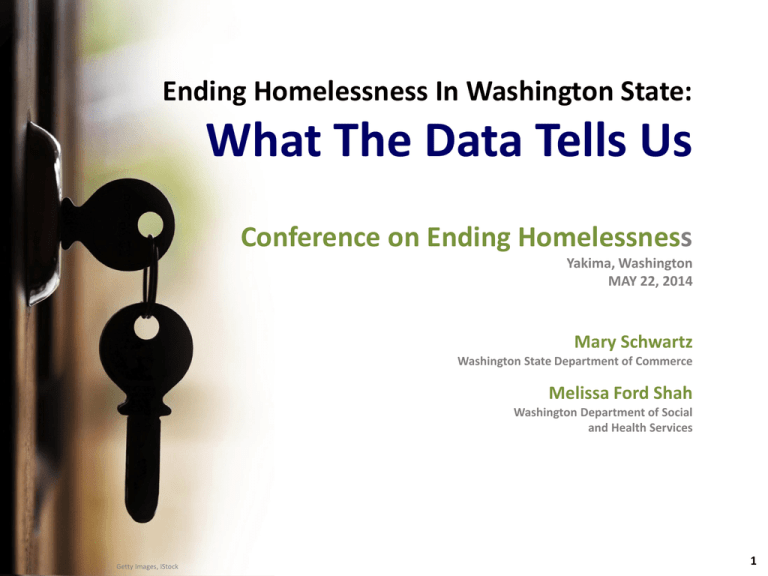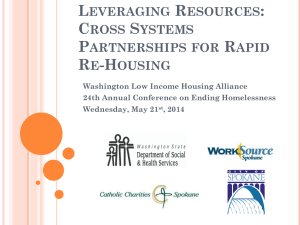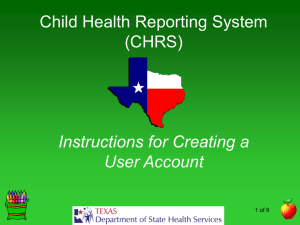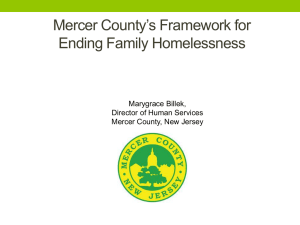Slideshow - Washington Low Income Housing Alliance
advertisement

Ending Homelessness In Washington State: What The Data Tells Us Conference on Ending Homelessness Yakima, Washington MAY 22, 2014 Mary Schwartz Washington State Department of Commerce Melissa Ford Shah Washington Department of Social and Health Services DSHS | Research and Data Analysis Division ● MAY 22, 2014 Getty Images, iStock 1 Roadmap 1. Two Efforts to End Homelessness in Washington State 2. DSHS-Commerce Research and Data Partnership 3. Informing the Chronic Homelessness Policy Academy 4. Data on the Ending Family Homelessness Pilot Project DSHS | Research and Data Analysis Division ● MAY 22, 2014 Getty Images, iStock 2 PART 1 Overview of Two Efforts to End Homelessness in Washington State DSHS | Research and Data Analysis Division ● MAY 22, 2014 Getty Images, iStock 3 Chronic Homelessness Policy Academy: Housing 3,000 Subcommittee MISSION STATEMENT Promote sustainable housing as part of recovery for chronically homeless people VISION Ending chronic homelessness for most vulnerable high cost system users FOCUS Develop and implement a model for ending the experience of chronic homelessness for 3,000 people identified in 2013, and replicate the model to a system-wide level by 2016 DSHS | Research and Data Analysis Division ● MAY 22, 2014 4 Chronic Homelessness Policy Academy: Housing 3,000 Subcommittee STEPS 1. End Chronic Homelessness in the State of Washington through targeted, solution-oriented approaches that can be scaled for efficacy around the State 2. Permanently house 3,000 people experiencing chronic homelessness in the State of Washington 3. Build a collaborative, integrated approach to identify and connect individuals who experience chronic homelessness with comprehensive services to support permanent housing DSHS | Research and Data Analysis Division ● MAY 22, 2014 5 Washington State Policy Academy Process Key Activities: WORKGROUP FOCUS NEXT STEPS Expanding Housing • Meet with key stakeholders to identify housing needs and opportunities • Bring together Federal, State and County level agencies and stakeholders Data • Integrate data to improve our understanding of the needs of homeless veterans • Analyze medical and behavioral health costs for homeless Medicaid clients • If awarded, a SAMHSA supplemental grant will fund an analysis of homeless veterans • CSH and WLIHA finalizing a White Paper that includes a medical cost analysis for chronically homeless individuals System Design • Configure the “pieces” of the • Working to add supportive overall Policy Academy activity to services to Medicaid benefit build a long term (and • Implementing BRIDGES grant, sustainable) solution to ending which provides behavioral health chronic homelessness in the State supportive housing services of Washington DSHS | Research and Data Analysis Division ● MAY 22, 2014 6 Ending Family Homelessness (EFH): Rapid Re-housing for Homeless Families on TANF • In April 2013, five counties (Cowlitz, Mason, Snohomish, Spokane and Whatcom) implemented a pilot program involving: – Active coordination with local CSOs, WorkSource, and housing providers – Goal of moving homeless TANF families into permanent housing immediately while connecting them to services so income could support that housing in 6 months • January 2014: Pilot program was expanded under the consolidated homeless grant (CHG); continued partnership between Commerce, DSHS and ESD • Statewide technical assistance being provided to EFH providers in partnership with Building Changes and the Gates Foundation • Research being conducted by RDA on outcomes of 80+ households served in the pilot DSHS | Research and Data Analysis Division ● MAY 22, 2014 7 PART 2 DSHS and Commerce Research and Data Partnership DSHS | Research and Data Analysis Division ● MAY 22, 2014 Getty Images, iStock 8 Washington State DSHS Integrated Client Database Incarcerations School Outcomes Preschool – College Education Research Data Center Arrests Charges Community Supervision Convictions Administrative Office of the Courts Washington State Patrol Department of Corrections Dental Services Medical Eligibility Medicaid, State Only Hospital Inpatient/ Outpatient Managed Care Hours Physician Services Births Prescription Drugs Wages Deaths Housing Assistance Emergency Shelter Transitional Housing Homeless Prevention and Rapid Re-housing Permanent Supportive Housing Health Care Authority Employment Security Department Department of Health Department of Commerce Public Housing Housing Choice Vouchers Multi-Family Project-Based Vouchers Housing and Urban Development Public Housing Authority De-identified DSHS Aging and LongTerm Support Nursing Facilities In-home Services Community Residential Functional Assessments WASHINGTON STATE External Department of Social and Health Services Internal INTEGRATED CLIENT DATABASE DSHS Children’s Services DSHS Developmental Disabilities Child Protective Services Case Management Child Welfare Services Community Residential Services Adoption Adoption Support Child Care Out of Home Placement Voluntary Services Personal Care Support Residential Habilitation Centers and Nursing Facilities Family Reconciliation Services DSHS | Research and Data Analysis Division ● MAY 22, 2014 DSHS Behavioral Health and Service Integration Mental Health and Substance Abuse Services Assessments Detoxification Opiate Substitution Treatment Outpatient Treatment Residential Treatment Child Study Treatment Center Children’s Longterm Inpatient Program Community Inpatient Evaluation/ Treatment Community Services DSHS Economic Services DSHS Juvenile Rehabilitation Food Stamps Institutions TANF and State Family Assistance Dispositional Alternative General Assistance Community Placement Child Support Services Parole Working Connections Child Care DSHS Vocational Rehabilitation Medical and Psychological Services Training, Education, Supplies Case Management Vocational Assessments Job Skills State Hospitals State Institutions 9 HMIS Housing Program Clients with DSHS Service History SFY 2013 HMIS ALL Housing Assistance Recipients Gave consent and had sufficient information for linking n = 91,524 n = 71,652 DSHS-HMIS HMIS Linked to DSHS Integrated Client Database n = 64,974 The vast majority of housing clients in HMIS have been DSHS clients • In State Fiscal Year (SFY) 2013, 78 percent of HMIS housing recipients gave consent and had sufficient information for linkage to DSHS records (71,652 of 91,524) • 91 percent of those who could possibly be linked were found in the DSHS Integrated Client Database (64,974 of 71,652) DSHS | Research and Data Analysis Division ● MAY 22, 2014 10 PART 3 Identifying Chronically Homeless Individuals in Washington State DSHS | Research and Data Analysis Division ● MAY 22, 2014 Getty Images, iStock 11 Data on chronic homelessness is missing for four counties in Washington because it is not part of the HMIS data standards WHATCOM SAN JUAN OKANOGAN FERRY STEVENS SKAGIT PEND OREILLE ISLAND SNOHOMISH CLALLAM Everett CHELAN JEFFERSON DOUGLAS LINCOLN KITSAP Spokane KING GRAYS HARBOR MASON Tacoma SPOKANE GRANT KITTITAS ADAMS WHITMAN PIERCE THURSTON PACIFIC LEWIS FRANKLIN GARFIELD YAKIMA WAHKIAKUM COWITZ COLUMBIA BENTON SKAMANIA WALLA WALLA ASOTIN KLICKITAT CLARK Vancouver DSHS | Research and Data Analysis Division ● MAY 22, 2014 12 Proportion of homeless population meeting criteria for chronic homelessness Chronically Homeless, January 2013 Point in Time Count Chronically Homeless, CY 2012 HMIS Entries* TOTAL HOMELESS IN STATE = 17,775 TOTAL CY 2012 ENTRIES IN HMIS = 22,158 Chronically Homeless Chronically Homeless* 12% 20% n = 2,219 n = 4,345 Homeless Homeless not chronically not chronically 88% 80% n = 15,556 n = 17,813 *NOTE: This data represents all HMIS entries in the state in CY 2012, with the exception of Clark, Pierce, Snohomish, and Spokane counties. These records are not unduplicated at the client level. DSHS | Research and Data Analysis Division ● MAY 22, 2014 13 Characteristics of Washington’s Chronically Homeless Population DEMOGRAPHICS TOTAL = 4,345* n = 1,573 n = 2,760 n = 359 n = 1,462 n = 699 *NOTE: This data represents all HMIS entries in the state in CY 2012, with the exception of Clark, Pierce, Snohomish, and Spokane counties. These records are not unduplicated at the client level. DSHS | Research and Data Analysis Division ● MAY 22, 2014 14 Characteristics of Washington’s Chronically Homeless Population HOMELESS EPISODES TOTAL = 4,345* Continuously Homeless 83% Frequently Homeless n = 3,627 48% n = 2,076 Both Continuously and Frequently Homeless 31% n = 1,358 *NOTE: This data represents all HMIS entries in the state in CY 2012, with the exception of Clark, Pierce, Snohomish, and Spokane counties. These records are not unduplicated at the client level. DSHS | Research and Data Analysis Division ● MAY 22, 2014 15 Characteristics of Washington’s Chronically Homeless Population HEALTH AND BEHAVIORAL HEALTH CONDITIONS TOTAL ENTRIES = 4,345* n = 612 n = 3,037 n = 1,702 n = 1,968 n = 2,089 *NOTE: This data represents all HMIS entries in the state in CY 2012, with the exception of Clark, Pierce, Snohomish, and Spokane counties. These records are not unduplicated at the client level. DSHS | Research and Data Analysis Division ● MAY 22, 2014 16 Identifying Chronically Homeless Population with the ICDB: Medical assistance clients meeting HUD definition Total Medical Assistance Population SFY 2012 = 1.5 million Met HUD definition of Chronically Homeless in SFY 2012 Homeless in SFY 2012 but not in June 2012 n = 9,642 48% n = 20,174 1.3% No. Did not receive HMIS-Recorded Housing Assistance n = 8,087 40% Homeless in June 2012 n = 10,532 52% Yes. Got Assistance 12% n = 2,445 DSHS | Research and Data Analysis Division ● MAY 22, 2014 17 PART 4 Data on the Ending Family Homelessness Pilot DSHS | Research and Data Analysis Division ● MAY 22, 2014 Getty Images, iStock 18 Monthly EFH Enrollment Trends by Pilot County APRIL – SEPTEMBER 2013 TOTAL = 277 249 245 235 Spokane n = 94 167 128 Snohomish n = 64 Cowlitz n = 37 35 Whatcom n = 30 Mason n = 20 SOURCE: The Ending Family Homelessness Pilot: Rapid Re-Housing for TANF Families, Ford Shah, et.al., DSHS Research and Data Analysis Division, January 2014. http://publications.rda.dshs.wa.gov/1498/ DSHS | Research and Data Analysis Division ● MAY 22, 2014 19 Average Monthly EFH Costs per Household APRIL – SEPTEMBER 2013 Average cost per month of program participation for all heads of household with reported EFH costs . . . RENT SECURITY DEPOSIT UTILITY DEPOSIT MOTEL/HOTEL COST ALL COSTS n = 71 n = 71 n = 71 n = 71 n = 71 $636 $180 $37 $36 $889 ALL COSTS Average cost per service user per service month . . . RENT SECURITY DEPOSIT UTILITY DEPOSIT MOTEL/HOTEL COST n = 70 n = 60 n = 16 n=8 $688 $592 $207 $800 n/a SOURCE: The Ending Family Homelessness Pilot: Rapid Re-Housing for TANF Families, Ford Shah, et.al., DSHS Research and Data Analysis Division, January 2014. http://publications.rda.dshs.wa.gov/1498/ DSHS | Research and Data Analysis Division ● MAY 22, 2014 20 Prior Living Situation Recorded in HMIS for EFH Recipients All others 57% n = 158 Emergency Shelter TOTAL = 277 38% n = 105 5% Place not meant for human habitation n = 14 67% 22% 11% n = 75 n = 25 n = 12 TOTAL = 112 19% 78% 3% n = 13 n = 53 n=2 TOTAL = 68 65% 35% n = 24 n = 13 TOTAL = 37 64% 36% n = 23 n = 13 TOTAL = 36 TOTAL = 24 96% 4% n = 23 n=1 SOURCE: The Ending Family Homelessness Pilot: Rapid Re-Housing for TANF Families, Ford Shah, et.al., DSHS Research and Data Analysis Division, January 2014. http://publications.rda.dshs.wa.gov/1498/ DSHS | Research and Data Analysis Division ● MAY 22, 2014 21 Three-Year Shelter Use History for EFH Participants: Chronic, Temporary, and Episodic Homelessness Chronic Homelessness Episodic Homelessness 2% n=6 10% Temporary Homelessness n = 29 No Prior Shelter 14% 42% n = 38 n = 115 Prior Shelter Not Recorded in HMIS* 32% 74% n = 89 TOTAL CASES = 277 n = 204 Three-Year History: EFH Clients with Prior Shelter Use in HMIS Average number of shelter episodes Average number of days in shelter Average number of days per episode Temporary Episodic Chronic TOTAL (n = 38) (n = 6) (n = 29) (n = 73) 1 9.8 9.8 2.3 6.3 3 1.1 89.1 86.6 1.1 41.0 39.8 *Program staff in the five pilot counties confirmed that these 89 individuals with prior shelter not recorded in HMIS were either 1) entering EFH from shelters not required to report into HMIS or 2) fleeing domestic violence when served in shelter. DSHS | Research and Data Analysis Division ● MAY 22, 2014 22 Issues Identified in the Comprehensive Evaluation: EFH Parents Compared to Other TANF Parents EFH TANF Other EFH EFH EFH EFH TANF Other TANF Other TANF Other TANF Other 0 n = 24 of 105 8,725 of 55,505 n = 23 of 105 4,578 of 55,505 n = 38 of 105 8,217 of 55,505 n = 22 of 105 5,962 of 55,505 n = 45 of 105 20,542 of 55,505 SOURCE: The Ending Family Homelessness Pilot: Rapid Re-Housing for TANF Families, Ford Shah, et.al., DSHS Research and Data Analysis Division, January 2014. http://publications.rda.dshs.wa.gov/1498/ DSHS | Research and Data Analysis Division ● MAY 22, 2014 23 Pregnancy and Ages of Children in the Household: EFH Parents Compared to Other TANF Parents EFH TANF Other EFH TANF Other EFH 0 EFH TANF Other n=8 of 105 5,719 of 55,505 n = 55 of 105 25,491 of 55,505 n = 32 of 105 17,737 of 55,505 n = 25 of 105 TANF Other EFH TANF Other n=0 of 105 973 of 55,505 11,974 of 55,505 SOURCE: The Ending Family Homelessness Pilot: Rapid Re-Housing for TANF Families, Ford Shah, et.al., DSHS Research and Data Analysis Division, January 2014. http://publications.rda.dshs.wa.gov/1498/ DSHS | Research and Data Analysis Division ● MAY 22, 2014 24 Percent Homeless or Unstably Housed: April 2011-March 2012 EFH Parents Other TANF Parents 2011 2012 SOURCE: The Ending Family Homelessness Pilot: Rapid Re-Housing for TANF Families, Ford Shah, et.al., DSHS Research and Data Analysis Division, January 2014. http://publications.rda.dshs.wa.gov/1498/ DSHS | Research and Data Analysis Division ● MAY 22, 2014 25 Behavioral Health and Medical Risk Indicators AMONG THOSE WITH MEDICAL COVERAGE Alcohol and/or Other Drug (AOD) Use 24-month baseline period Mental Health Medical Indicators 24-month baseline period 12-month baseline period EFH EFH TANF Other TANF Other EFH EFH TANF Other EFH TANF Other 0 n = 26 8,575 of 105 of 55,505 EFH EFH n = 20 4,436 of 105 of 55,505 n = 52 20,579 of 105 of 55,505 n = 52 19,374 of 105 of 55,505 n = 16 4,958 of 105 of 55,505 TANF Other n = 29 11,525 of 105 of 55,505 n = 24 6,853 of 105 of 55,505 SOURCE: The Ending Family Homelessness Pilot: Rapid Re-Housing for TANF Families, Ford Shah, et.al., DSHS Research and Data Analysis Division, January 2014. http://publications.rda.dshs.wa.gov/1498/ DSHS | Research and Data Analysis Division ● MAY 22, 2014 26 EFH children were less likely to have had a foster care placement and more than twice as likely to experience poor health conditions IN BASELINE YEAR Foster Care Placement Proportion with Poor Health Status In 12-Month Baseline Period Among those with Medical Coverage EFH TANF Other EFH TANF Other 0 n = 4 of 145 4,156 of 104,899 0 n = 6 of 145 2,164 of 104,899 SOURCE: The Ending Family Homelessness Pilot: Rapid Re-Housing for TANF Families, Ford Shah, et.al., DSHS Research and Data Analysis Division, January 2014. http://publications.rda.dshs.wa.gov/1498/ DSHS | Research and Data Analysis Division ● MAY 22, 2014 27 Coming Attractions . . . • Youth at Risk of Homelessness (YARH) Planning Grant Predicting homelessness among youth exiting foster care • Vulnerable Families Partnership and TANF PRISM Predicting homelessness among TANF households and providing information to caseworkers on key risk factors • Ending Family Homelessness (EFH) Evaluating the impact of the program on key outcomes for EFH participants compared to a statistically matched comparison group of their peers • Housing and Essential Needs (HEN) Evaluating the impact of HEN on key outcomes for recipients compared to a statistically matched comparison group of their peers DSHS | Research and Data Analysis Division ● MAY 22, 2014 28 Identifying Homeless and Unstably Housed DSHS Clients in Multiple Service Systems APRIL 2012 • Shah, Black, Felver http://publications.rda.dshs.wa.gov/1457/ The Housing Status of Individuals Discharged from Behavioral Health Treatment Facilities JULY 2012 • Shah, Black, Felver http://publications.rda.dshs.wa.gov/1460/ Impact of Housing Assistance on Short-Term Homelessness Among TANF, Disability Lifeline, and Basic Food recipients with recently recorded spells of homelessness SEPTEMBER 2011 • Shah, Estee, Mancuso, Black, Felver http://publications.rda.dshs.wa.gov/1443/ A Profile of Housing Assistance Recipients in Washington State: History of Arrests, Employment, and Social and Health Service Use MARCH 2011 • Shah, Estee, Albrecht, Yette, Felver http://publications.rda.dshs.wa.gov/1438/ DSHS | Research and Data Analysis Division ● MAY 22, 2014 29 Permanent Options for Recovery-Centered Housing: Year 1 Annual Report JUNE 2012 • Galvez, Lucenko, Black, Felver http://publications.rda.dshs.wa.gov/1462/ Intensive Case Management within a Supportive Housing Facility OCTOBER 2008 • Shah, Mancuso, Nordlund, Felver http://publications.rda.dshs.wa.gov/1367/ Washington State’s Housing and Essential Needs Program Impacts on Housing Status, Use of Food Assistance, Arrests, Incarcerations, and Health Outcomes JANUARY 2013 • Mancuso, Ford Shah, Black, Felver http://publications.rda.dshs.wa.gov/1476/ Behavioral Health Risk among TANF Parents: Links to Homelessness, Child Abuse and Arrests DECEMBER 2010 • Shah, Mancuso, He, Estee, Felver, Beall, Fiedler http://publications.rda.dshs.wa.gov/1429/ DSHS | Research and Data Analysis Division ● MAY 22, 2014 30 For more Information . . . . Mary Schwartz mary.schwartz@commerce.wa.gov Melissa Ford Shah shahmf@dshs.wa.gov DSHS | Research and Data Analysis Division ● MAY 22, 2014 Getty Images, iStock 31








